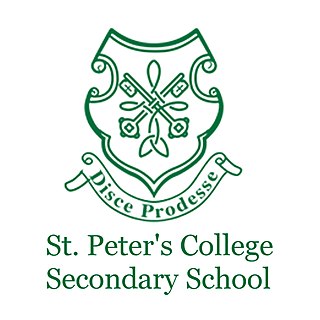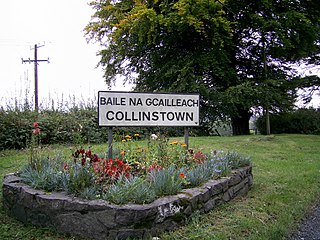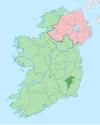
Tullow is a market town in County Carlow, Ireland. It is located on the River Slaney where the N81 road intersects with the R725. As of 2022, the population was 5,138.

St Patrick's, Carlow College, is a liberal arts college located in Carlow, Ireland. The college is the second oldest third level institution in Ireland and was founded in 1782 by James Keefe, then Roman Catholic Bishop of Kildare and Leighlin, and his co-adjutor bishop Daniel Delany.
Dr Cullen Park, known for sponsorship reasons as Netwatch Cullen Park, is a GAA stadium in Carlow, County Carlow, Ireland. It is the home of the Carlow Gaelic football and hurling teams. It has a capacity of 11,000.

Newcestown is a small village located 35 km from the city of Cork in the western part of County Cork, Ireland. It is a village with a church, a school, a pub and GAA club. Newcestown is part of the Dáil constituency of Cork North-West.

St Peter's College, Wexford is an Irish secondary school and former seminary located in Summerhill, overlooking Wexford town. It is a single-sex school for male pupils. Currently, the school's population is over 770.

Collinstown is a village in north County Westmeath, situated on the R395 regional road overlooking Lough Lene. It lies 18 km (11 mi) northeast of the county town of Mullingar and had a population of 356.

Effin is a townland and civil parish in County Limerick, Ireland. It is on the R515 road, midway between Kilmallock and Charleville. The population of the parish is about 1,000. Effin is partly in the barony of Costlea, but chiefly in that of Coshma. The parish lies in the Golden Vale, Munster's rich dairyland, and intensive dairying is practised there. The Ballyhoura Mountains, which separate County Limerick from County Cork, are at the southern end of the parish.

Trillick St Macartan's is a Gaelic Athletic Association club based in the parish of Trillick in western County Tyrone, Northern Ireland. It competes at Senior level in Tyrone GAA competitions. The club plays Gaelic football, ladies' Gaelic football and camogie.

English Martyrs Catholic School is a coeducational Roman Catholic secondary school and sixth form located in Leicester, England. The school's new buildings had their official opening in May 2015.

The Cathedral of the Assumption is both the cathedral church of the Roman Catholic Diocese of Kildare and Leighlin and the parish church for the cathedral parish. Located in Carlow town, the cathedral was dedicated to the Assumption of the Blessed Virgin Mary in 1833. It is known for its beautifully detailed 151 ft (46 m) spire which is one of the highest points in the town.

Milltown is a small village in County Cavan, Ireland. The population as at 2021 was around 100. During a nineteenth century O'Donavan townlands survey of County Cavan it was noted that the Milltown area was traditionally referred to as Bellanaleck, there are no other records with this name. The Archaeological Inventory of County Cavan notes (507) Derrygeeraghan, a raised circular Rath area with two substantial earthen banks and a wide deep fosse dating from earlier medieval times. The present Milltown Electoral Division and catchment area comprises several neighboring townlands within an ancient Barony of Loughtee Lower, County Cavan and Drumlane Civil Parish in County Cavan.
The 2015 Carlow Senior Hurling Championship was the 86th staging of the Carlow Senior Hurling Championship since its establishment by the Carlow County Board in 1887. The championship began on 11 July 2015 and ended on 18 October 2015.

Killoughternane Church is a 10th-century Celtic Christian church located in County Carlow, Ireland. It was built on the remains of a timber church said to have been built by Fortiarnán in the 5th century AD.
The history of St. Mary's Church in Dedham, Massachusetts begins with the first mass said in Dedham, Massachusetts in 1843 and runs to the present day.

Glenmore is a village in County Kilkenny, Ireland. It lies just off the N25 road close to the border between County Kilkenny and County Wexford. Glenmore GAA is the local Gaelic Athletic Association club, and Glenmore National School is the local primary (national) school. Saint James's Catholic Church in Glenmore was built in 1813.

The Carlow county football team represents Carlow in men's Gaelic football and is governed by Carlow GAA, the county board of the Gaelic Athletic Association. The team competes in the three major annual inter-county competitions; the All-Ireland Senior Football Championship, the Leinster Senior Football Championship and the National Football League.
The 2020 Carlow Senior Hurling Championship was the 91st staging of the Carlow Senior Hurling Championship since its establishment by the Carlow County Board in 1927. The championship began on 24 July 2020 and ended on 30 August 2020.

Rathvilly Gaelic Athletic Association is a Gaelic football and ladies' Gaelic football club based in Rathvilly, County Carlow, Ireland.
The 2023 Carlow Senior Hurling Championship was the 94th staging of the Carlow Senior Hurling Championship since its establishment by the Carlow County Board in 1927. The championship ran from 28 June to 13 August 2023.
The 2022 Carlow Senior Hurling Championship was the 93rd staging of the Carlow Senior Hurling Championship since its establishment by the Carlow County Board in 1927. The draw for the opening round fixtures was made on 24 March 2022. The championship ran from 17 June to 7 August 2022.
















